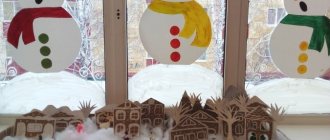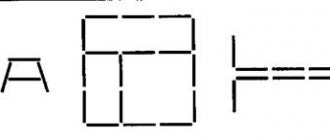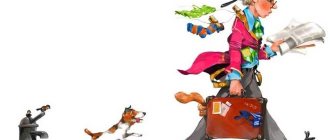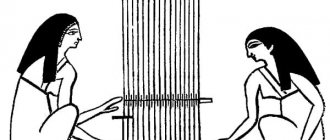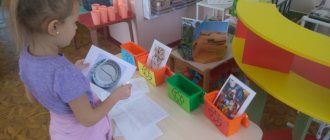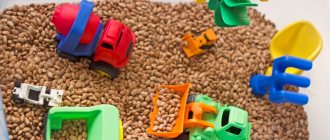Fourth wheel
Target. Development of thinking.
Task. Familiarization with the surroundings (clothes, shoes, hats).
Equipment. Subject pictures with images of clothes, shoes, hats.
Progress of the game
The teacher will put pictures on the typesetting canvas with images of three items of clothing and one pair of shoes or three pairs of shoes and one headdress and invites them to examine and name them. You can invite children to remember poems, nursery rhymes, and riddles about these objects. Then the children are given the task of determining which picture is odd and why.
You can play the game in a similar way by placing on a typesetting canvas three pictures with images of multi-colored clothes and one with images of plain clothes, or three pictures with images of clothes for winter and one picture with images of clothes for summer, etc.
What's missing? Target. Development of visual attention and perception. Task. Familiarization with the surroundings (clothes, shoes, hats).
Equipment. Subject pictures with images of clothes, shoes, hats.
Progress of the game
The teacher will place pictures on the typesetting canvas with images of four to five items of clothing, shoes, and hats, asking them to examine and name them. You can invite children to remember poems, nursery rhymes, and riddles about these objects. Then the children are asked to close their eyes. At this time, the teacher removes one of the pictures. Having opened their eyes, children must determine what is missing.
What changed? Target. Development of visual attention and perception. Task. Familiarization with the surroundings (clothes, shoes, hats).
Equipment. Subject pictures with images of clothes, shoes, hats.
Progress of the game
The teacher will put pictures with images of clothes, shoes, and hats on the typesetting canvas, asking them to look at and name them. You can invite children to remember poems, nursery rhymes, and riddles about these objects. Then the children are asked to close their eyes. At this time, the teacher swaps two pictures or puts another instead of one picture (thin socks instead of woolen socks). Having opened their eyes, children must determine what has changed or which pictures have swapped places.
What appeared? Target. Development of visual attention and perception. Task. Getting to know those around you! (clothes, shoes, hats).
Equipment. Subject pictures with images of clothes, shoes, hats.
Progress of the game
The teacher places pictures with images of four to five items of clothing, shoes, and hats on the typesetting canvas, asking them to examine and name them. You can invite children to remember poems, nursery rhymes, and riddles about these objects. Then the children are asked to close their eyes. At this time, the teacher places another picture on the typesetting canvas. Having opened their eyes, children must determine what object has appeared.
Choose a scheme
Target. Development of sound word analysis skills.
Task. Familiarization with the surroundings (clothes, shoes, hats).
Equipment. Subject pictures with images of a hat, fur coat, jacket, raincoat. Cards with sound patterns of these words.
Progress of the game
The teacher places pictures with images of a hat, fur coat, jacket, and cap on the typesetting canvas. Children look at the pictures and name them. Then the teacher invites the children to take one card with a sound diagram of the word from a bag, chest or container. Children complete the task and then look at the diagrams. Next, they are given the task of putting diagrams under those pictures whose names correspond to the diagrams in terms of sound composition.
Syllabic domino Goal. Improving the skill of syllabic analysis of words.
Equipment. Subject pictures with images of clothes, shoes, hats (scarf, raincoat, fur coat, hat, trousers, dress, leggings, sneakers, mittens, overalls). Cards with images of one, two, three and four squares.
Progress of the game
The teacher will place pictures of clothes, shoes, and hats on the typesetting canvas. Children look at and name them. The teacher puts cards with images of one, two, three and four squares in a row. He explains that the squares represent the number of syllables in the names of objects. Next, children are given the task of arranging pictures with images of clothes, shoes and hats into a square, depending on how many syllables their names are divided into.
Exercise poem for studying clothes
And here is a version of the exercise rhyme. It will help you repeat with your child not only the names of items of clothing, but also the colors. Additionally, it will help you concentrate on what you are saying.
Children with (red shirts/blue pants/etc.), Children in (red shirts/blue pants/etc.),
Children with (red shirts/blue pants/etc.), Children in (red shirts/blue pants/etc.),
Please stand up, please stand up. Please stand up, please stand up.
Clap your hands and turn around
Clap your hands and turn around
Then sit down, then sit down. Then sit down, then sit down.
Preview:
Goals:
Expand children's knowledge about clothing. Enrich children's vocabulary on the topic. Teach children to classify clothes according to a given criterion (winter or summer, women's or men's). Reinforce the concepts of color, size, shape, quantity. Develop thinking, attention, fine motor skills.
Equipment:
Cut-out pictures depicting various clothes. (for convenience and durability, we have them laminated with tape), a box with clothespins, images of a boy and a girl, cardboard strips of different colors (blue, yellow, pink, red, green). Progress of the game:
Option 1: “Name the clothes and their details”
The teacher asks you to select one item of clothing from the box and name the details (collar, pocket, hood, buttons, etc.)
Option 2 “Clothes for boys and girls”
The mother washed her son and daughter's clothes and asked them to carefully hang their clothes to dry using clothespins. Show your son, daughter. Girls' clothes should be hung on pink stripes, boys' clothes should be hung on blue stripes. Help children hang their clothes correctly.
Option 3 “Seasonal clothes”
Let's use clothespins to attach clothes that can be worn in summer (winter, spring, autumn) to colored stripes.
Attach winter clothes to the blue stripe, summer clothes to the red stripe, autumn clothes to the yellow stripe, and spring clothes to the green stripe. For each strip from one to three items of clothing. How many did you get on your strip of clothing? Who is this clothing for - a boy or a girl? What colour?
Weekly calendar plan on the topic “Clothing” for preschool educational institutions
Topic: "Clothing"
Monday.
Morning.
1. Games: sedentary “Guide”. Goal: To develop a sense of responsibility for another person. Cultivate trust in each other.
2. Didactic “Who is attentive?” Goal: Develop auditory attention
3. Conversation “The tramp wind turns the weather.” To form children’s ideas about the relationship between weather phenomena and clothing.
4. Observation and work in a corner of nature “Watering indoor flowers.” Goal: to enrich children’s experience in the ability to care for flowers: water them correctly. Develop curiosity. Foster a sense of responsibility.
5. Errands - we wipe down the shelves of the cabinets in the play area. Objectives: Teach children to perform this work operation, talk about its purpose. To form the beginnings of a responsible attitude towards the assigned task, to support the desire to complete the task.
6. Formation of the group of groups. Cultivate the habit of quickly dressing and undressing, hanging clothes in a certain order and place.
GCD. 1. Speech therapy
2. H.E.R. Modeling “New winter clothes”
Software tasks:
Teach children to work in an unconventional visual technique - plasticineography.
Strengthen the ability to create the integrity of an object from individual parts, using existing skills: pressing parts to the base, smearing, smoothing the boundaries of the connection of individual parts; encourage the use of cereals and beads to add expressiveness to the image. To consolidate children's knowledge of the concept of “winter clothing”
. Develop fine motor skills of the fingers, pressure on plasticine, a sense of shape and rhythm. To develop the relationship between aesthetic and artistic perception in children’s creative activities. To develop children's auditory attention, memory, perception, imagination. Cultivate a caring attitude towards clothing and accuracy when doing work.
Equipment:
pictures depicting people dressed in different clothes depending on the time of year, a set of plasticine, cereals, beads, modeling boards, stacks, paper and wet wipes for hands, silhouette figures of children cut out of cardboard, a sheet of Whatman paper with drawn winter fun.
Vocabulary work:
zipper, cufflinks, cuffs, floors
Methodical techniques:
org. moment I. Surikov’s poem “White Snow”, conversation about winter clothes, children’s stories, finger play, questions, reminder, independent and ind. Job,
incentives, result.
3. H.E.R. Musical
Walk
1. Observing bird tracks in the snow. Tasks: Invite children to look at the tracks in the snow, guess which of them belong to birds, and discuss who could have left the other tracks. To develop children's powers of observation and cognitive interest.
2. Didactic games “Game of riddles.” Develop coherent speech and thinking.
3. Experiments “Winter Sun”. Objectives: Invite children to use simple experiments to find out whether the sun warms well. Bring the children to the conclusion that the sun weakly warms the earth, tell them that it does not rise high, its path across the sky becomes shorter.
4. Labor - organize snow removal. Objectives: to cultivate hard work and responsibility for the assigned work.
5. Individual work. Practice your ability to jump on one leg.
6. Outdoor games: “Burners”, “Hunter and Hares”. Ts: Develop accuracy, speed, attention.
Afternoon
1. Reading the fairy tale “The Magic Needle” by V. Oseeva. Goal: learn to establish cause-and-effect relationships.
2. D/i “On the contrary.” C: Develop the ability to compare objects by size (length, width, coordinate adjectives with nouns in gender, number, and select antonyms.
3. P/i “Sleeping Fox” - develop the ability to change the direction of movement on a signal, develop coordination of movements, dexterity.
4. OBZH “The Snow Queen” Goal: To help the child see positive character traits in every person.
5. Hood. activity: Application “I am a fashion designer” Tasks: Continue to teach children to work according to their own sketch, made independently. Strengthen the ability to work in the decoupage technique.
Walk
1. Observing people’s clothes; adults and children put on warm clothes. Ask what this is about. Fix the names of winter clothes.
2. P/N “Freeze!” Independent play activities on the site.
Tuesday.
Morning.
1. Individual work “Find an object along the contour.” Goal: to develop children’s imagination, the ability to find an object by shape, contour; the ability to prove your point of view. Cultivate interest in playing together.
2. D/i “Match a button to your clothes.” Continue to work on strengthening the habit of helping peers in children.
3. Conversation “Shoes and hats.” To form and expand children's knowledge about shoes and hats.
4. Observation and work in a corner of nature Purpose: To expand children’s knowledge about the needs of plants for light and moisture, to teach how to recognize moisture-loving and drought-resistant, light-loving and shade-tolerant plants by their leaves.
5. Duty in a corner of nature: develop the ability to maintain order in a corner and perform appropriate work actions. Foster responsibility and independence.
GCD. 1. Speech therapy
2. P.R. FEMP "
Composition of number 6
»
Program tasks:
Learn to form the number 6 from two smaller numbers and decompose it into two numbers. Continue to introduce the formation of numbers of the second ten within 15. Introduce the measurement of quantities using a conditional measure. Develop the ability to navigate in space using symbols and diagrams.
Vocabulary work:
half, quarter, card
Material:
numbers, group plan, hidden toys in the group, quarters, halves and whole models of apples, counting sticks, notebooks, pencils.
Methodical techniques:
org. moment “Days of the week”, composing the number 6, counting within 15, measuring with a quarter, physical exercise, orientation in the “Find a toy according to the plan” group, work in a notebook, summary.
3. H.E.R. Musical
II
half.
day H.E.R. Drawing “ Russian folk costume
”
Program tasks:
generalization and concretization of children’s knowledge about the history of Russian national costume; developing children’s ability to make patterns on paper by printing with a foam rubber stamp on a stencil; activation and enrichment of the vocabulary, nurturing a sense of love for the Motherland, pride in one’s people and culture.
Materials and equipment:
illustrations for fairy tales: “Hen Ryaba”, “Geese-Swans”, dolls in Russian national costumes, a chest, a Russian folk sundress, a scarf, a shirt, a blouse, a birch tree. Blank silhouettes of sundresses for drawing, gouache, foam rubber pokes, stencils of floral patterns, audio recording: “There was a birch tree in the field,” “Baps and bast shoes.”
Vocabulary work:
ornament, shell, braid
Methodical techniques:
org. moment - introducing illustrations and dolls, looking at them, talking about Russian traditions and costumes, vocabulary work, dynamic pause “Baps and bast shoes”, showing the method of drawing, ind. and independent work, the result, the round dance song “There was a birch tree in the field.”
Walk
1. Watching a sparrow. Goal: expand ideas about birds; develop the ability to analyze, compare, and draw conclusions.
2. D/i “Call me affectionately.” Ability to select words in diminutive forms. Activation of the dictionary.
3. Experiments - look at the tracks of birds, compare them with each other, guess whose tracks they might be.
4. It’s laborious to pour bird food into the feeders on the property. Objectives: To develop hard work and the desire to help birds during the cold season. Cultivate a love for wintering birds.
5. Phys. exercises: “Jumping on two legs.” goal: to develop the ability to jump on two legs.
6. Individual work to reinforce the ATS “Bring the bag of food.” Purpose: to practice balance.
7. P/games: “Fishing Rod” - develop dexterity and reaction speed
Afternoon
1. Reading the story by K. D. Ushinsky “How a shirt grew in a field.” Give an idea of the plant origin of the fabric.
2. P\i “Needle, thread and knot.” Develop attention and motor activity.
3. D\i “How we dress.” Strengthen children's knowledge about clothing.
4. S/r i. “Shop”: plot “Selection of winter hats and winter shoes”
5. Listening to a musical fairy tale: “The Brave Little Tailor.” Develop emotional perception of a musical fairy tale.
6. OBZh “Winter roads”. Goal: to expand children’s knowledge about the rules of behavior on the street and the road in winter.
7. Manual labor “Salon of beautiful clothes” (Working with paper). Objectives: Teach children to use a previously prepared sketch (pencil sketch) in their work. Practice working with scissors, cutting along the drawn outline.
Walk
1. Situational conversation “You need to know how to dress yourself.” Fix the sequence of dressing and undressing.
2. S/R game “Fashion Atelier” Purpose: to teach children to model clothes, to consolidate its elements.
3. P/N “We are funny guys.” Develop attention and motor activity.
Wednesday.
Morning.
1. Individual work. Goal: Continue learning to cut out circles, smoothly rounding the corners of the squares; cut the squares diagonally to create triangles.
2. Games: sedentary “Edible - inedible”. Goal: to develop children's attention, dexterity, and endurance. Cultivate interest in joint games.
3. Didactic “We’ll find out what dresses and suits are made of, who made them, where they came from.”
4. Conversation “The invention of the needle.” Goal: To introduce children to the evolution of the needle from antiquity to the present day.
5. Observation and work in a corner of nature - note with the children the weather conditions in the evening. Develop the ability to observe, analyze and draw conclusions.
6. Canteen duty - develop the ability to interact in the process of joint work: distribute responsibilities, negotiate among themselves
7. Formation of CGN “Learning to keep clothes in order” - to form CGN and self-care skills.
GCD. 1. Speech therapy
2. S.K.R. LIFE SAFETY FUNDAMENTALS "
Clothing and human health
»
Program objectives:
Tell children about the types and purposes of clothing. Expanding knowledge about clothing. Cultivating neatness. Development of thinking, speech, activation of children's vocabulary. Formation of spiritual health, aesthetic education.
Vocabulary work:
home, holiday, sports, work, for traveling, for dancing, for every day, professional (police, military, medical, etc.).
Material:
Katya doll with a set of various clothes, cardboard shoe blanks with holes and laces.
Methodical techniques:
surprise moment Katya doll, conversation about clothes, ways to care for clothes, the meaning of clothes in a person’s life, reminder, children’s stories, competition game “Who can fasten buttons, zippers, tie a bow faster,” result
3. H.E.R. Musical
Walk
1. Observing the weather, comparing the weather during the week, developing the ability to make forecasts.
2. D/i “It happens - it doesn’t happen” (with a ball). Develop coherent conversational speech.
3. Experience “Filter – what is it and what is it made of?” Goal: to introduce children to the concept of “filter”, from which it can be made: “paper, gauze, mesh, cotton wool.” Develop the ability to compare and draw conclusions. Cultivate curiosity.
4. Labor. Clearing snow from the path leading to the feeder. Tasks: teach correctly, use a shovel, finish what you start.
5. Physical exercises: “Run to the flag.” Tasks: teach to monitor compliance with the rules, perform the duties of a judge, coach. Develop dexterity and attention.
6. Individual work to consolidate the ATS P/i: “Sovushka”. Develop attention
Afternoon
1. Reading fiction V. Sukhomlinsky “Shiny Shoes.” Goal: to reinforce ideas about hard work and laziness.
2. Printed board games. Teach children to independently choose and organize play, and interact with peers. Develop attention, develop the ability to exercise self-control.
3. P/i “Fishing Rod” - develop dexterity and speed of reaction
4. D/i “Go I don’t know where, find something I don’t know what.” Goal: to arouse interest and desire to play a mathematical game.
Walk.
1. Observing the weather, comparing morning and evening weather.
2. P/N “Whose unit will gather sooner?” Cultivate interest in joint games.
Thursday.
Morning.
1. Individual work Name the clothes and shoes on... Consolidating knowledge about clothing and its parts. Activation of the dictionary.
2. Didactic “Atelier”. Train the ability to classify clothes according to seasonality.
3. Conversation “How fabrics are woven and threads are spun.” Develop ideas about fabric making.
4. Game-experimentation “Dyeing fabric” - introduce children to the properties of water and dyes.
5. Independent activity - games at the request of children. Teach children to make structures from building materials according to diagrams, three-dimensional images, and develop spatial perception.
6. Class duty - teach children to select handouts, count out the required amount of materials for the lesson, lay them out on the work tables; cultivate responsibility and hard work.
7. Game situation “Visiting Moidodyr” Form the habit of keeping your body clean. Teach children to wash themselves after sleep without spilling water on the floor.
GCD. 1. Speech therapy
2. P.R. FEMP "
Composition of the number 8
»
Program tasks:
learn to form the number 8 from two smaller numbers and decompose it into two smaller numbers. Fix quantitative counting within 10. Practice measuring the length of objects using a conventional measure. Develop the ability to navigate on a sheet of squared paper. Cultivate curiosity.
Vocabulary work:
size, orientation, even and odd numbers.
Material:
numbers, handouts, conventional measurements, length strips, notebooks, pencils.
Methodical techniques:
org. moment “Name the day of the week”, composing the number 8 from two smaller ones, counting objects, correlating the number and number of objects, measuring strips along the length using a conventional measure, physical training, work in notebooks, summary.
3. H.E.R. Drawing "
Clothes
»
Program tasks:
Expand and concretize ideas about clothing, its purpose, and the details of which it consists. Develop phrasal speech; auditory attention, memory. Satisfy children's curiosity through play situations. Develop coherent speech: learn to form plural nouns; numbers; develop the ability to draw with colored pencils, crayons, felt-tip pens. Strengthen the ability to hold a pencil correctly. Activate creative imagination (decorate “clothes” according to plan).
Material and equipment:
ball, easel, pictures of clothes, pictures of clothes, colored pencils, wax crayons, felt-tip pens.
Vocabulary work:
closet, pinched, overalls.
Methodical techniques:
org. moment “Name the clothes”, conversation about parts of the clothes, purpose, reading a fairy tale about how the clothes were offended, p/g “Clothes”, physical minute, drawing clothes, d/i “Name it affectionately”, result.
Physical education in games on a walk No. 11
Walk
1. Observation of snowfall. Purpose: - to give an idea of the movement of snow in windy weather
2. Didactic games “Tell me which one?” Train the ability to form relative adjectives.
3. Experiments “Transferring a sun bunny”. Purpose: to show with an example how light and the image of an object can be reflected repeatedly.
4. Labor. Clearing the labyrinth from snow. Objectives: to cultivate a desire to collectively improve your site.
5. Physical exercises: Performing exercises to maintain balance. Goal: to develop endurance.
6. P/n: “The fox in the hen house.” Objectives: To teach children to gently jump from a height to a designated place, to maintain balance when landing. Develop creativity in motor activity, cultivate self-confidence.
Afternoon
1. Reading the poem by L. Voronkova “Masha the Confused Man.” Introduce the concept of “fashion”, learn to name types of clothing and their elements.
2. OBZH “Games on modules”. Goal: to teach children safe behavior while playing on the modules.
3. Hood. activity: Modeling “Hat” Purpose: To teach children to sculpt oval-shaped objects and flatten them. Reinforce techniques for sculpting oval-shaped objects. Cultivate accuracy in work.
4. Independent activity - games at the request of the children “What are clothes made of?” Objectives: Teach children to recognize clothing materials (leather, cotton, synthetics, silk
Walk
1. P/n: “Fishing Rod” - develop the ability to jump high
2. D/i “Go I don’t know where, find something I don’t know what.” Goal: to arouse interest and desire to play a mathematical game. Develop the ability to lead a person, understand the concepts of “right, left, forward, backward”, the ability to describe an object without naming it. Cultivate curiosity.
3. S/r i. “Atelier” distribute roles, use substitute items.
Friday.
Morning.
1. Individual work “Complete the sentence.” Practice agreeing numerals with nouns.
2. Games: sedentary “Kolobok” Purpose: To develop communication skills, imagination; work on expressiveness of speech.
3. Didactic “The fourth odd one” Objectives: To develop children’s attention and logic.
4. Conversation “Why does a person need clothes?” Clarify the functions and purpose of different clothing; to concretize the knowledge that a person needs different clothes (in cold and warm weather, for relaxation, holidays)
5. Observation and work in a corner of nature “green landing on indoor plants” (removing diseased leaves, fertilizing). Goal: To teach children to determine by the condition of indoor plants what actions are necessary to care for them (watering, cleaning, loosening, fertilizing, correctly perform the relevant labor operations, invite the children to tell about the purpose of each of them.
6. Duty “Setting the table beautifully” - continue to teach children how to set the table themselves, and carefully perform the role of duty officer.
7. “How to take care of yourself” - educate the KGN, teach you to take care of your appearance.
GCD. 1. Speech therapy
2. H.E.R. /ETC. Construction "
Atelier
»
Program tasks:
teach children to cut out parts according to a ready-made template, systematize children’s ideas about clothes, shoes, hats, and their purpose; activate speech; continue to train children in working with the template; develop fine motor skills; teach children to cut out small parts; cultivate artistic taste.
Material:
pictures of various clothes, paper dolls (girls and boys), templates for clothes, shoes, hats, white paper, colored paper, scissors, glue, pictures of accessories (for cutting out)
Vocabulary work:
put on, dress, patterns, outfit.
Methodical techniques:
org. moment. d/i “What do you have?”, combine with similar objects, d/i “What kind of clothes are there?”, “Say it correctly”, physical exercise, independent and ind. work, result.
3. P.R. FCCM "
Clothes
»
Program tasks:
Enriching children's knowledge about clothing. Expand children's understanding of the world around them. To form in children a clear, differentiated understanding of different types of clothing, their purpose and use. Summarize children's knowledge about natural and artificial types of fabric, about their origin. To cultivate a caring attitude towards things as the result of people’s labor, to cultivate a friendly attitude towards each other. Develop and activate children's speech.
Equipment:
pictures depicting items of clothing, plot pictures depicting children (or fairy-tale characters) in different types of clothing (festive attire, school or formal suit, etc.), a tablecloth for the table, fabric samples, a tray for each child, a magnifying glass for each child.
Vocabulary work:
designer, fashion designer, rags, linen, cotton, knitwear.
Methodical techniques:
org. “Magic Ball” moment, reading S. Marshak’s passage “Here’s how absent-minded”, posing a problem situation, d/i “Find clothes for the season”, physical minute, laboratory, examining fabrics, experiments with fabrics, comparison, drawing up a descriptive story according to a diagram, reflection.
II
half.
day F.R. Physical education No. 22 Walk
1. Why does the change of day and night occur? Purpose: - to give an idea of how the change of day and night occurs.
2. D/i “Does this happen or not?” Objectives: to develop logical thinking in children, to develop the ability to compare and contrast, and to identify inconsistencies.
3. Research activities. Rays of light always travel in a straight line, and if any object gets in their way, it casts a dark shadow. Conduct observation - morning, noon, evening. Conclude that at noon the sun is directly overhead, so the shadow is very short; Early in the morning and in the evening the sun drops in the sky, the shadows become long.
4. It’s difficult to clear the snow from the veranda floor. Objectives: teach how to perform labor actions.
5. Physical exercises: “Don’t knock down the flag.” Goals: continue to “snake” between objects without knocking them over; develop attention and observation.
Afternoon
1. Reading K. Chukovsky “The Miracle Tree”. Ability to formulate common sentences on a topic and answer questions.
2. D/i: “Let’s dress the doll for a walk.” Develop the ability to find shades darker or lighter.
3. S/r game “Livestock Breeders”. Objectives: to develop children’s social skills, the ability to negotiate, agree on a game, distribute roles, look for ways out of conflict situations
4. Quiz on the topic: “Clothes, shoes, hats”
5. Life safety “Winter roads” Purpose: to expand children’s knowledge about the rules of behavior on the street and roads in winter.
6. Hood. activity: “Home” Purpose: To introduce children to the isothread technique.
Walk
1. Observation of the sky, it gets dark early, stars appear. Develop observation skills.
2. P/I “Day-Night”. Strengthen the ability to move according to a signal.
Exercises and games - Clothes in English for children
Match the words with the picture
Match the words with the picture. This is the most obvious game, but it is effective.
Guess who?
Guess who? In the picture there are children dressed in colorful clothes, the child must choose someone and describe in a few words what he is wearing, and you try to guess.
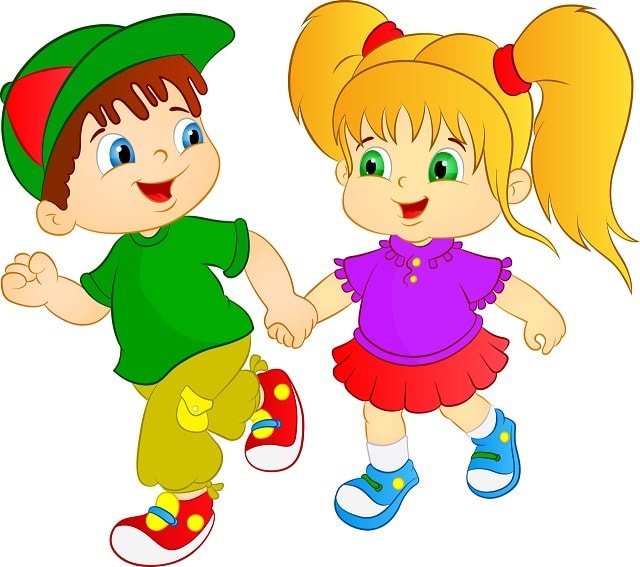
Crossword
Crossword. It is possible that the child will not yet be able to spell the word, but at first you can fill in the empty squares; in this case, the child will be required to provide the correct name for the item of clothing.
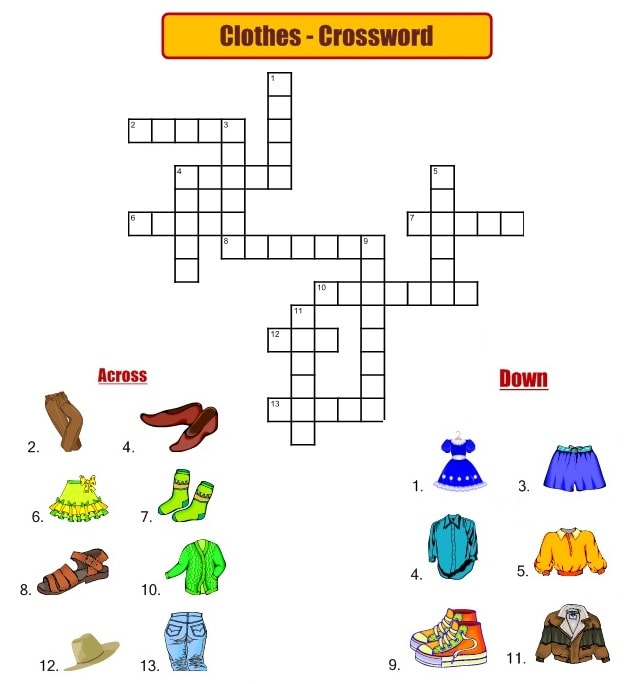
Coloring pages
Coloring pages. If your child is a creative person, then he should like various coloring options, with and without captions; from some options you can cut out game cards. Or, let's say, you will describe a thing in English, and the child must find this thing in the picture and color it in the right color.
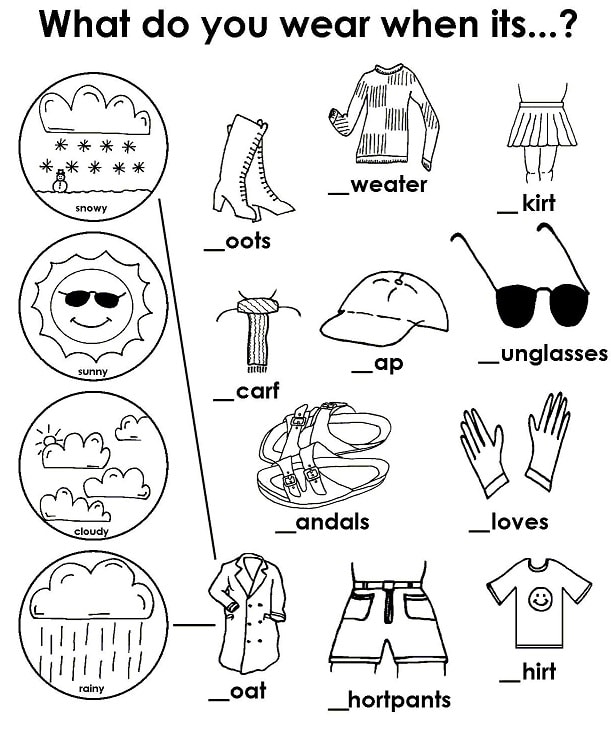
What am I wearing?
What am I wearing? The child is shown a photograph or picture for a certain time, after which the picture is removed, and the child describes what clothes were shown in the picture.
Paired cards
Paired cards. Prepare two sets of cards with the same pictures, on one the signature will be in English, on the second in Russian. When everything starts to work out quickly, the pictures can be made different, for example, a blue cap of one style, and a red cap of another.
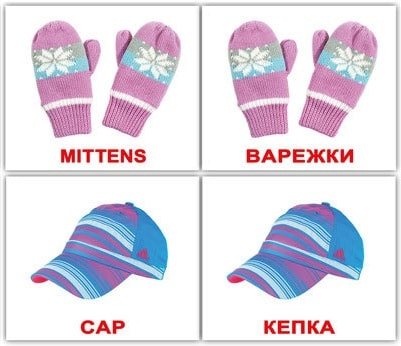
Gallows
Gallows. Surely in childhood many played this game with their parents. It can be very coolly adapted to play with English words. Now you have learned a certain number of words with your child, and now think of a word, write the first letter or letter in the middle of the word, and mark the rest with dashes. Let the child guess the letters or the word, but with your clues, for example, this thing is on you. This game will help you better remember the pronunciation and spelling of words.
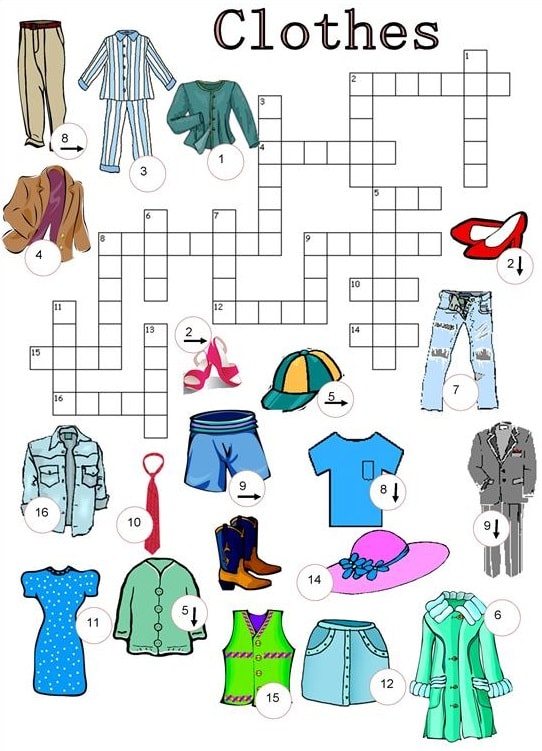
Video song about clothes in English for children
You can find a theme song on almost any topic. They are specially invented to support children's interest in the topic, as well as to make the lesson more fun.
The song can be just an ordinary audio file that you turn on, but it will be much more effective to support the song with visual material.
Here, for example, is a funny song with a small visual cartoon:
Let us remind you once again that it is not a bad idea to reinforce the rhymes and songs you are learning with visuals, for example, if you are reading a poem about a yellow sweater and blue jeans, prepare cards with images of these things.
